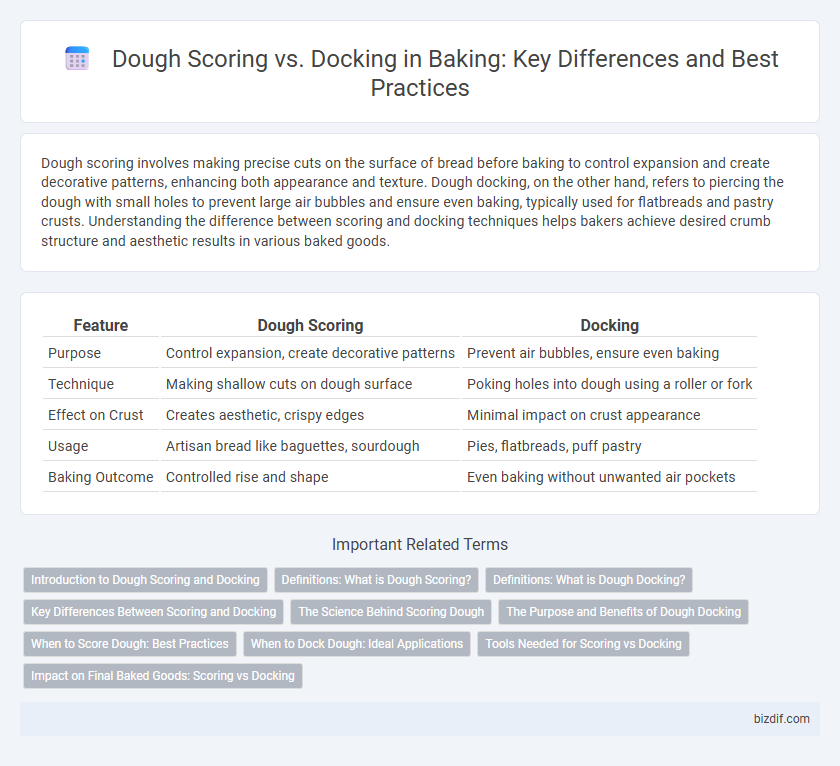Dough scoring involves making precise cuts on the surface of bread before baking to control expansion and create decorative patterns, enhancing both appearance and texture. Dough docking, on the other hand, refers to piercing the dough with small holes to prevent large air bubbles and ensure even baking, typically used for flatbreads and pastry crusts. Understanding the difference between scoring and docking techniques helps bakers achieve desired crumb structure and aesthetic results in various baked goods.
Table of Comparison
| Feature | Dough Scoring | Docking |
|---|---|---|
| Purpose | Control expansion, create decorative patterns | Prevent air bubbles, ensure even baking |
| Technique | Making shallow cuts on dough surface | Poking holes into dough using a roller or fork |
| Effect on Crust | Creates aesthetic, crispy edges | Minimal impact on crust appearance |
| Usage | Artisan bread like baguettes, sourdough | Pies, flatbreads, puff pastry |
| Baking Outcome | Controlled rise and shape | Even baking without unwanted air pockets |
Introduction to Dough Scoring and Docking
Dough scoring involves making precise cuts on the surface of bread dough before baking to control expansion and create decorative patterns, enhancing both texture and appearance. Docking, on the other hand, uses a tool with multiple spikes to perforate the dough, preventing large air bubbles and ensuring even baking. Both techniques are essential for achieving consistent crumb structure and optimal crust development in artisanal and commercial bakery products.
Definitions: What is Dough Scoring?
Dough scoring refers to the technique of making deliberate shallow cuts or slashes on the surface of bread dough before baking to control expansion and create decorative patterns. This practice influences the bread's crust texture, allowing gases to escape and preventing uncontrolled cracking during oven spring. Scoring not only enhances the bread's aesthetic appeal but also affects its final shape and oven rise.
Definitions: What is Dough Docking?
Dough docking is the process of perforating dough with small holes using a tool called a docker to allow steam to escape during baking, preventing unwanted air bubbles and uneven rising. This technique is commonly used in flatbreads, pizza crusts, and pastries to maintain a consistent texture and shape. Docking ensures a more uniform bake by controlling the dough's expansion and avoiding blistering on the surface.
Key Differences Between Scoring and Docking
Dough scoring involves making deliberate shallow cuts on the surface of the dough to control expansion and create decorative patterns during baking, while docking refers to puncturing the dough with multiple small holes to prevent excessive rising and air bubbles. Scoring enhances the bread's aesthetic and allows precise control over crust formation, whereas docking is primarily used to maintain a uniform thickness in products like pizza crusts or flatbreads. The key difference lies in scoring's role in artistic expression and controlled rise versus docking's function in managing dough structure and preventing unwanted puffing.
The Science Behind Scoring Dough
Dough scoring involves making precise cuts on the dough's surface to control steam release and expansion during baking, which enhances crust texture and prevents irregular cracking. The science behind scoring relies on directing the dough's natural gas expansion along these incision lines, promoting uniform oven spring and optimal crumb structure. Unlike docking, which pierces the dough to prevent excessive rising, scoring strategically manages expansion to balance aesthetics and bakery product quality.
The Purpose and Benefits of Dough Docking
Dough docking involves piercing the dough with small holes to release trapped gases, preventing excessive rising and ensuring an even crumb structure in baked goods. This technique enhances texture by minimizing large air pockets and promotes uniform baking, reducing the risk of dough blistering or uneven puffiness. Docking improves dough handling and final product appearance, making it essential for items like pizza crusts, pie bases, and flatbreads.
When to Score Dough: Best Practices
Scoring dough involves making precise cuts on the surface just before baking to control expansion and enhance crust texture, ideal for artisan breads like boules and baguettes. It is best practiced when the dough has undergone its final proof and has reached optimal elasticity to prevent tearing and ensure uniform oven spring. Proper scoring depth and pattern not only influence the loaf's aesthetic but also improve gas release, leading to an evenly baked, visually appealing bread.
When to Dock Dough: Ideal Applications
Docking dough is ideal for pie crusts, pizza bases, and flatbreads where preventing excessive puffing and ensuring even cooking is essential. This technique involves piercing the dough with a docker or fork to create small holes that allow steam to escape during baking. Docking is especially useful for unleavened doughs or those with minimal rising agents to maintain a flat, crisp texture without unwanted air pockets.
Tools Needed for Scoring vs Docking
Dough scoring requires specialized tools such as a baker's lame or a sharp razor blade to create precise cuts on the dough surface, promoting controlled expansion during baking. Docking involves using a dough docker tool, featuring multiple small spikes or wheels, to perforate the dough and prevent large air bubbles from forming. Both scoring and docking tools are essential for achieving the desired texture and appearance in artisan bread and pastries.
Impact on Final Baked Goods: Scoring vs Docking
Dough scoring creates controlled expansion points that enhance the bread's aesthetic and contribute to an open crumb structure, promoting even baking and crust development. Docking involves puncturing the dough to prevent excessive rising, resulting in a denser, flat texture ideal for items like crackers or pizza bases. Choosing between scoring and docking significantly impacts the final baked goods' texture, appearance, and structural integrity.
Dough scoring vs Docking Infographic

 bizdif.com
bizdif.com